Daikin FTXS30HVJU, FTXS36HVJU, FTXS30LVJU, FTXS36LVJU User Manual
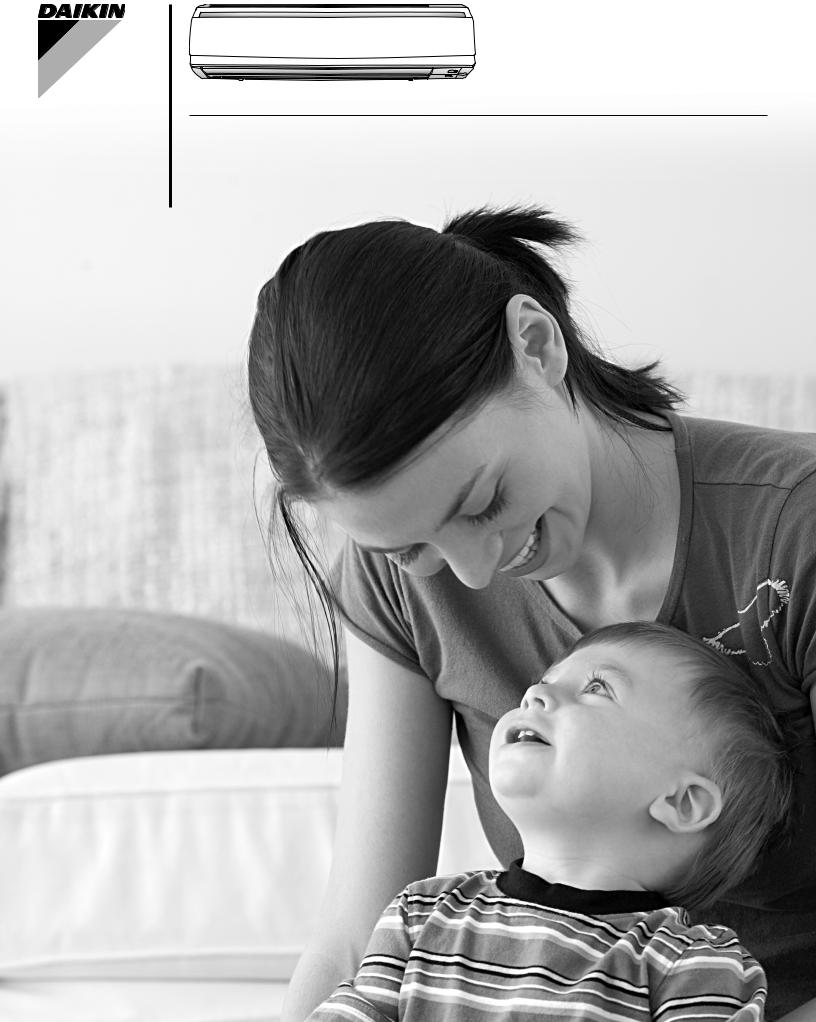
DAIKIN ROOM AIR CONDITIONER
OPERATION MANUAL
Español Français English
MODELS
FTXS30HVJU
FTXS36HVJU
FTXS30LVJU
FTXS36LVJU
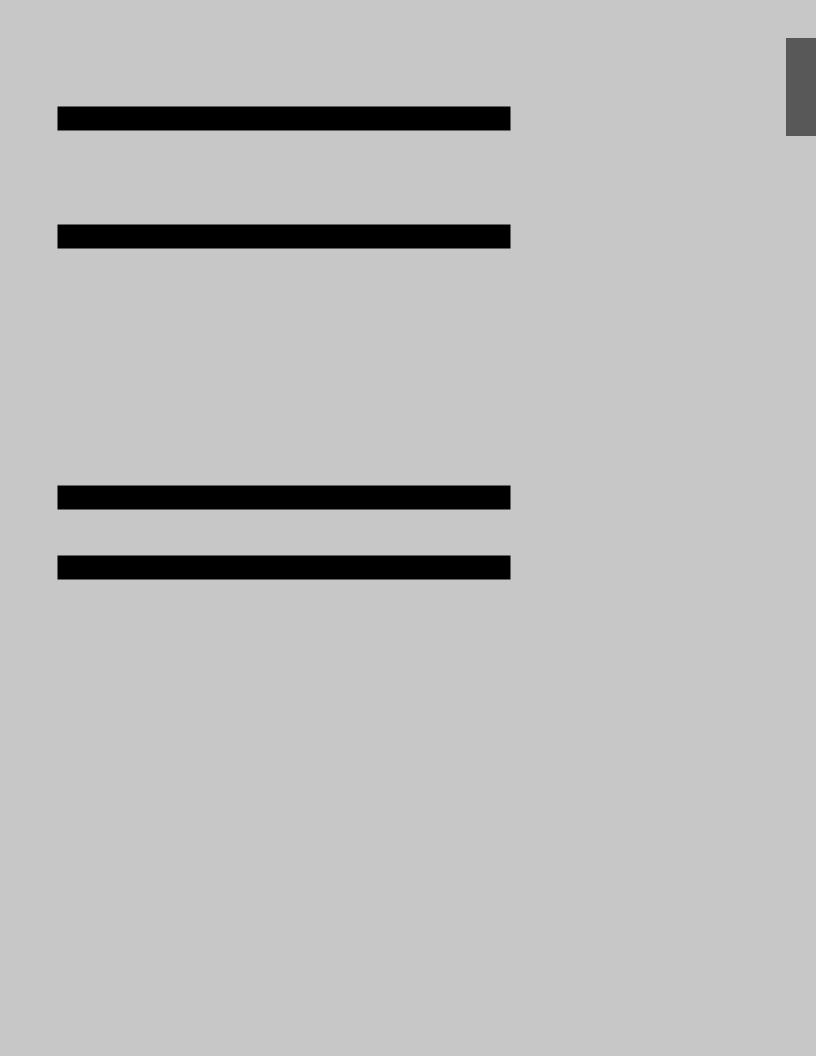
CONTENTS |
|
READ BEFORE OPERATION |
|
Safety Precautions.................................................................... |
2 |
Names of Parts ......................................................................... |
4 |
Preparation before Operation ................................................... |
8 |
OPERATION |
|
AUTO · DRY · COOL · HEAT · FAN Operation ....................... |
10 |
Adjusting the Airflow Direction ................................................ |
12 |
COMFORT AIRFLOW Operation............................................ |
14 |
INTELLIGENT EYE Operation................................................ |
15 |
POWERFUL Operation........................................................... |
17 |
OUTDOOR UNIT QUIET Operation ....................................... |
18 |
ECONO Operation.................................................................. |
19 |
TIMER Operation.................................................................... |
20 |
WEEKLY TIMER Operation .................................................... |
22 |
CARE |
|
Care and Cleaning.................................................................. |
29 |
TROUBLESHOOTING |
|
Troubleshooting ...................................................................... |
33 |
English
1
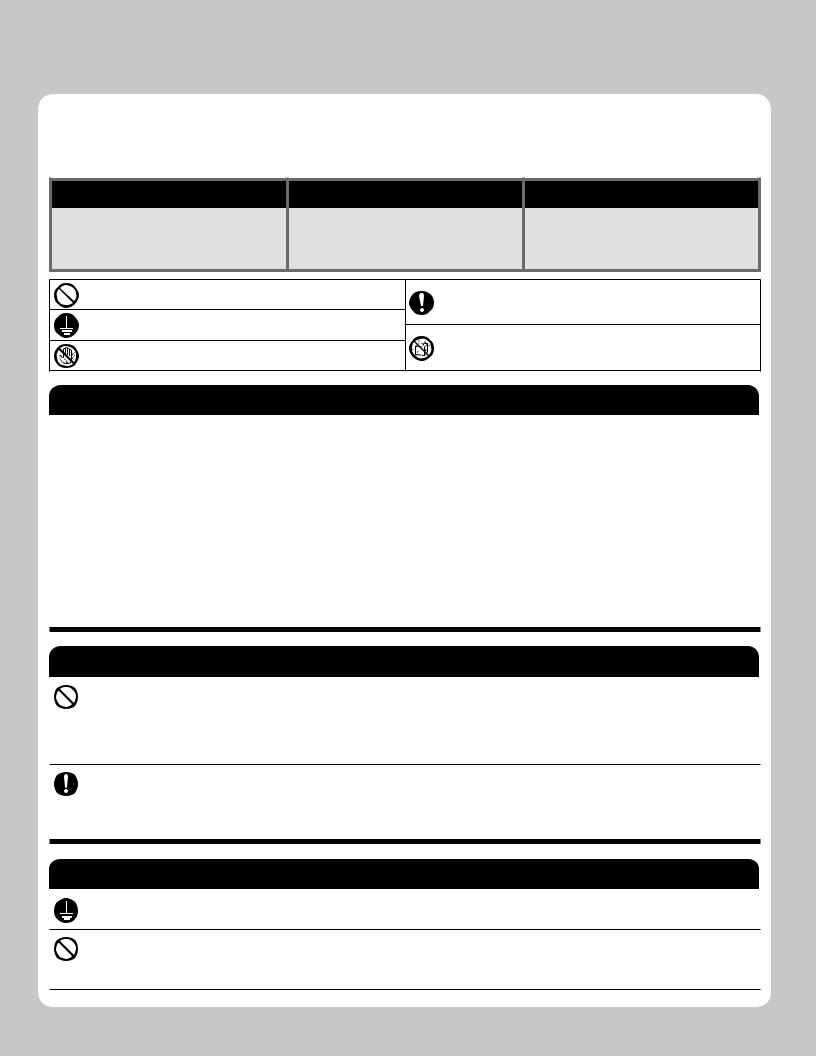
Safety Precautions
•Read these safety considerations for operations carefully before installing air conditioning equipment. After completing the installation, make sure that the unit operates properly during the startup operation. Instruct the customer on how to operate and maintain the unit.
Inform customers that they should store this operation manual with the installation manual for future reference. Meanings of DANGER, WARNING, CAUTION, and NOTE Symbols:
 DANGER
DANGER
Indicates an imminently hazardous situation which, if not avoided, will result in death or serious injury.
 WARNING
WARNING
Indicates a potentially hazardous situation which, if not avoided, could result in death or serious injury.
 CAUTION
CAUTION
Indicates a potentially hazardous situation which, if not avoided, may result in minor or moderate injury. It may also be used to alert against unsafe practices.
Never do.
Be sure to ground the air conditioner.
Never touch the air conditioner (including the remote controller) with a wet hand.
Be sure to follow the instructions.
Never allow the air conditioner or remote controller to get wet.
 DANGER
DANGER
•For refrigerant leakage, consult your dealer.
Refrigerant gas is heavier than air and replaces oxygen. A massive leak could lead to oxygen depletion, especially in basements, and an asphyxiation hazard could occur leading to serious injury or death.
•Refrigerant gas may produce a toxic gas if it comes in contact with fire such as from a fan heater, stove or cooking device. Exposure to this gas could cause severe injury or death.
•Any abnormalities in the operation of the air conditioner such as smoke or fire could result in severe injury or death. Turn off the power and contact your dealer immediately for instructions.
•Do not install the unit in an area where flammable materials are present due to risk of explosion resulting in serious injury or death.
•If equipment utilizing a burner is used in the same room as the air conditioner, there is the danger of oxygen deficiency which could lead to an asphyxiation hazard resulting in serious injury or death.
Be sure to ventilate the room sufficiently to avoid this hazard.
•Safely dispose of the packing materials.
Packing materials, such as nails and other metal or wooden parts, may cause stabs or other injuries. Tear apart and throw away plastic packaging bags so that children will not play with them. Children playing with plastic bags face the danger of death by suffocation.
 WARNING
WARNING
•It is not good for health to expose your body to the air flow for a long time.
•Do not put your finger or other objects into the air outlet or inlet as the fan is rotating at high speed and could cause injury. Always keep small children away from the unit during operation.
•Do not attempt to repair, relocate, modify or reinstall the air conditioner by yourself. Incorrect work or modifications could cause electric shocks, fire or other damage.
For repairs and reinstallation, consult your Daikin dealer for advice and information.
•If the air conditioner is not cooling (heating) properly, the refrigerant may be leaking, contact your authorized dealer or qualified service repairman.
When making repairs which requires adding refrigerant, consult with your authorized dealer or qualified service repairman.
•Do not attempt to install the air conditioner by yourself. Improper installation could result in water leakage, electric shocks or fire. For installation, consult your authorized dealer or a qualified technician.
 CAUTION
CAUTION
•The air conditioner must be grounded. Improper grounding may result in electric shocks. Do not connect the grounding wire to a gas pipe, water pipe, lightning rod, or a telephone ground line. Follow all local and state electrical codes.
•Do not use this unit for cooling precision instruments, food, plants, animals or works of art.
•Never expose little children, plants or animals directly to the air flow.
•Do not block air inlets nor outlets. Impaired air flow may result in poor performance or equipment problems.
•Do not stand, sit, or place objects on the outdoor unit. To avoid injury, do not remove the fan guard.
2
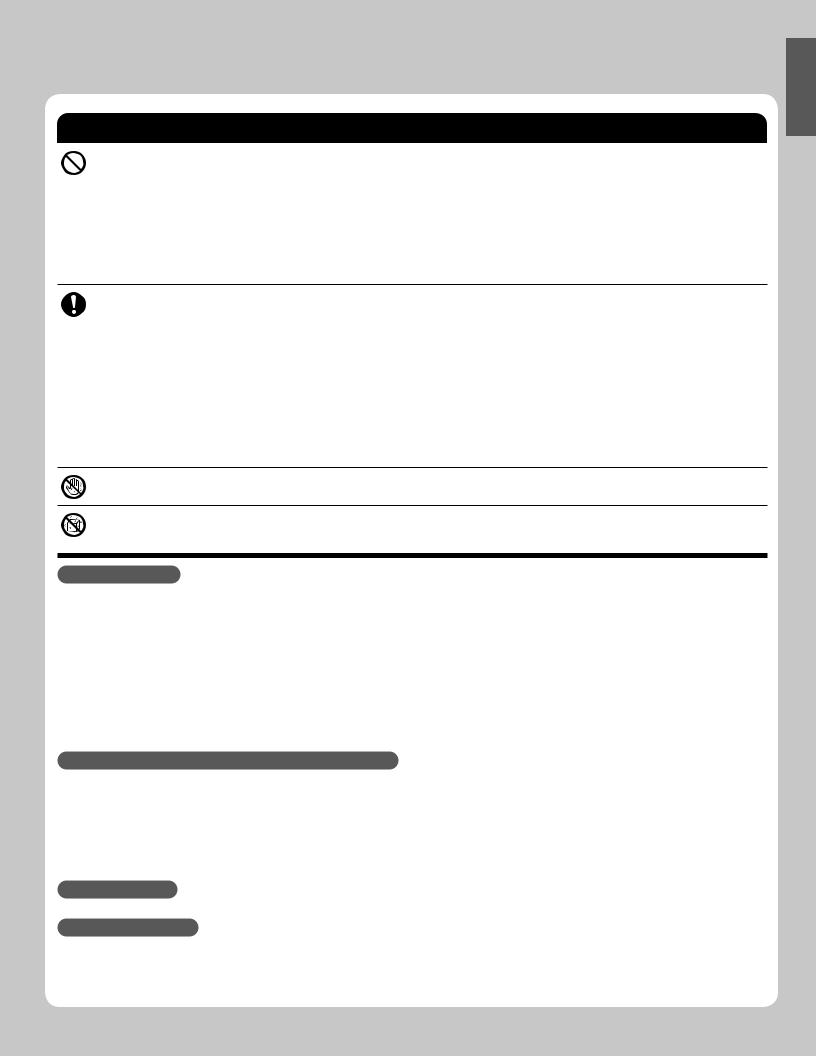
English
 CAUTION
CAUTION
•Do not place anything under the indoor or outdoor unit that must be kept away from moisture, such as electrical or electronic equipment. In certain conditions, moisture in the air may condense and drip.
•Check the unit stand and fittings for damage annually.
•Do not touch the air inlet and aluminum fins of outdoor unit. It may cause injury and/or damage the heat transfer surface.
•This appliance is NOT intended for use by young children or impaired persons without proper supervision.
•Young children should be supervised to ensure that they DO NOT play with or near the air flow of this appliance.
•Do not pull at the conduit or hang anything on it. Otherwise it will cause fire or electric shock.
•Do not touch the heat exchanger fins. Improper handling may result in injury.
•Do not turn off the power immediately after stopping operation. Always wait at least 5 minutes before turning off the power to avoid water leakage or other problems.
•To avoid personal injury or equipment damage be sure to stop the operation, turn the breaker off or pull out the supply cord before cleaning or servicing the unit. NOTE: More than one disconnect may be required to shut off all power.
•Do not connect the air conditioner to a power supply different from the one specified. It may cause improper operation or fire.
•Depending on the environment, state and local electrical codes, a ground fault circuit interrupter may be required. Improper grounding or lack of a ground fault circuit interrupter may result in electrical shock, injuries, or death.
•It is recommended to install a ground fault circuit interrupter if one is not already available. This helps prevent electrical shocks or fire.
•Arrange the drain hose to ensure smooth drainage. Improper drainage may cause water damage to the building, or its furnishing.
•Depending on the usage environment, water may leak from the air conditioner. If this happens, contact your Daikin Dealer.
•The remote controller should be installed in such away that children cannot play with it.
•Do not place objects in direct proximity of the outdoor unit and do not let leaves and other debris accumulate around the unit. Leaves are a hotbed for small animals which can enter the unit. Once in the unit, such animals can cause malfunctions, smoke or fire when making contact with electrical parts.
•Do not operate the air conditioner with wet hands.
•Do not wash the indoor unit with excessive water, only use a slightly wet cloth.
•Do not place things such as vessels containing water or anything else on top of the unit. Water may penetrate into the unit and degrade electrical insulations, resulting in an electric shock.
Installation site.
Operate the air conditioner in a sufficiently ventilated area and not surrounded by obstacles. Do not use the air conditioner in the following places.
a.Places with a mist of mineral oil, such as cutting oil.
b.Locations such as coastal areas where there is a lot of salt in the air.
c.Locations such as hot springs where there is a lot of sulfur in the air.
d.Locations such as factories where the power voltage varies a lot.
e.In cars, boats, and other vehicles.
f.Locations such as kitchens where oil may splatter or where there is steam in the air.
g.Locations where equipment produces electromagnetic waves.
h.Places with an acid or alkaline mist.
i.Places where fallen leaves can accumulate or where weeds can grow.
Consider the nuisance of noise to your neighbors.
Pay Attention to Operating Sound. Be sure to use the following places:
a.Places that can sufficiently withstand the weight of the air conditioner yet can suppress the operating sound and vibration of the air conditioner.
b.Places where warm air from the air outlet of the outside unit or the operating sound of the outside unit does not annoy neighbors. Make sure that there are no obstacles close to the outside unit. Obstacles close to the outside unit may drop the performance of the outside unit or increase the operating sound of the outside unit.
Consult your dealer if the air conditioner in operation generates unusual noise.
Electrical work.
• For power supply, be sure to use a separate power circuit dedicated to the air conditioner.
System relocation.
Relocating the air conditioner requires specialized knowledge and skills. Please consult the dealer if relocation is necessary for moving or remodeling.
3
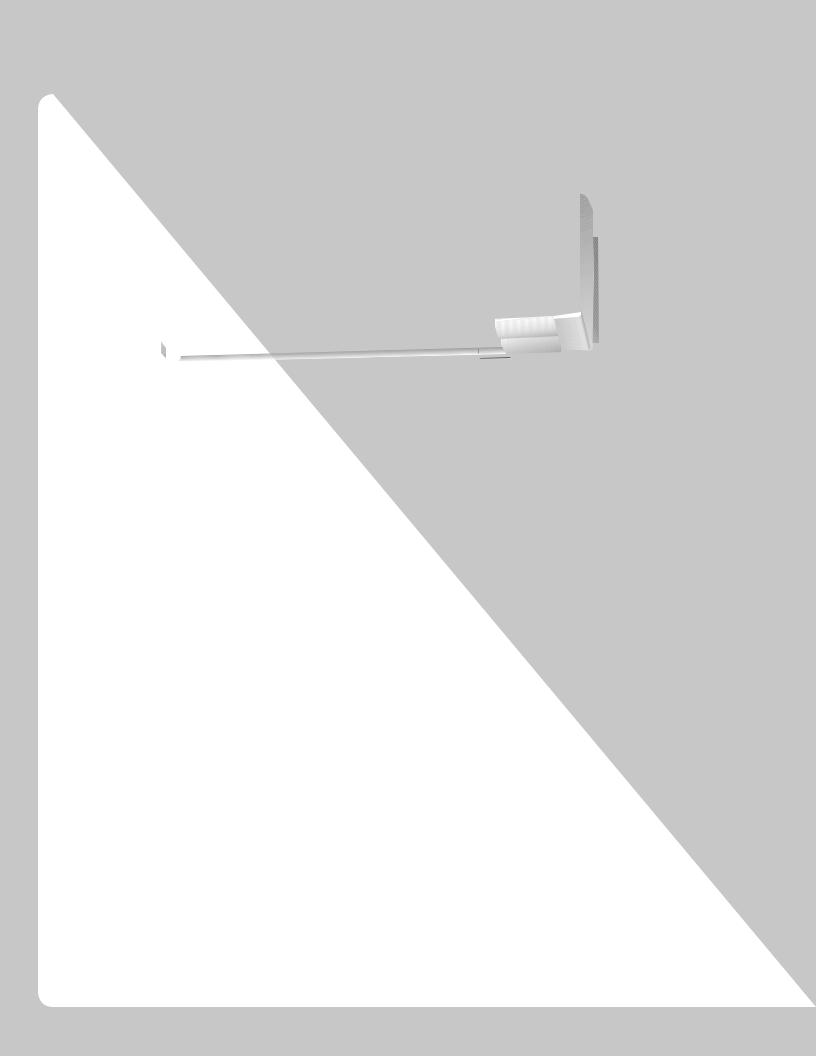
Names of Parts
Indoor Unit
Front panel |
|
|
Air inlet |
|
|
||
|
|
|
|
|
|
|
|
Panel tab
Model name plate
Air outlet
Fins (vertical blades)
•The fins are inside of the air outlet.  Page 12
Page 12
Louvers (horizontal blades)
 Page 12
Page 12
INTELLIGENT EYE sensor
•It detects the movements of people and automatically switches between normal operation and energy saving operation.  Page 15
Page 15
Room temperature sensor
•It detects the air temperature around the unit.
|
Display |
|
OPERATION lamp (green) |
Signal receiver |
TIMER lamp (yellow) Page 20 |
|
|
• It receives signals from the remote |
INTELLIGENT EYE lamp |
controller. |
|
• When the unit receives a signal, |
(green) Page 15 |
you will hear a beep sound. |
|
• Operation start ......... beep-beep |
|
• Settings changed ..... beep |
|
• Operation stop ......... |
long beep |
Indoor unit ON/OFF switch |
•Push this switch once to start operation. Push once again to stop it.
•The operation mode refer to the following table.
Model |
Mode |
Temperature setting |
Airflow rate |
COOLING ONLY |
COOL |
72°F (22°C) |
AUTO |
HEAT PUMP |
AUTO |
77°F (25°C) |
AUTO |
• This switch is useful when the remote controller is missing.
4
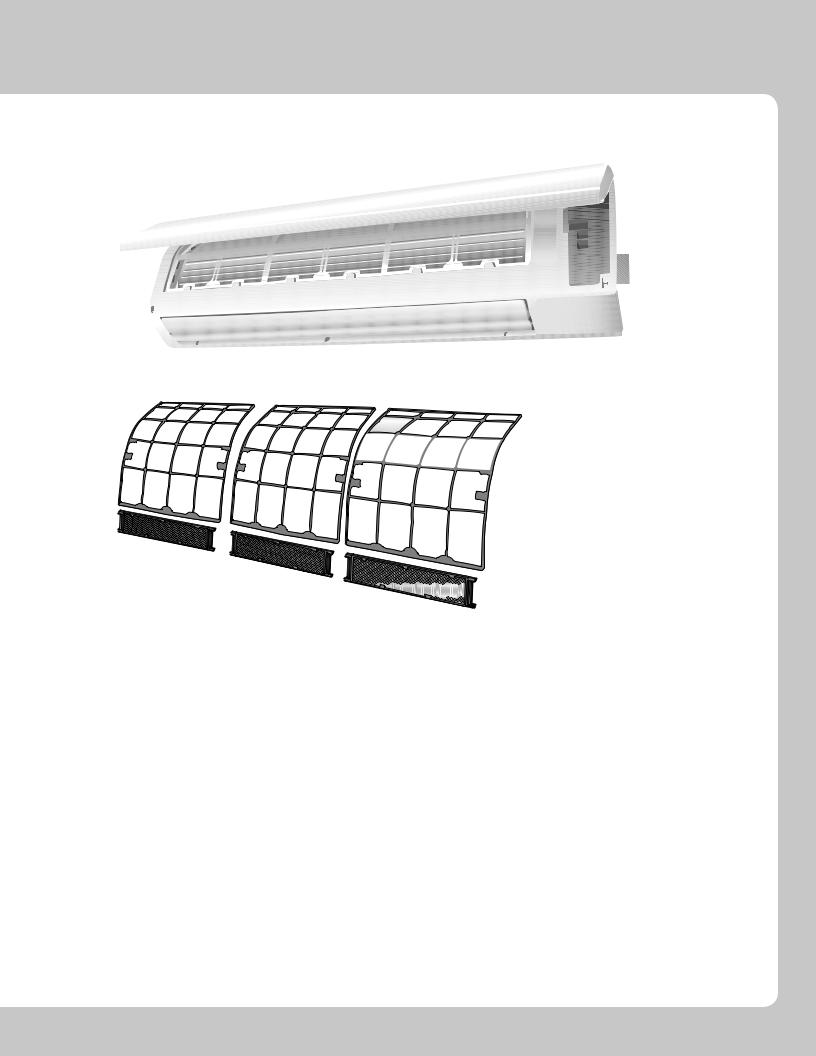
Open the front panel


 Air filter
Air filter















 Titanium apatite photocatalytic
Titanium apatite photocatalytic 

 air-purifying filter
air-purifying filter
Outdoor Unit
• Appearance of the outdoor unit may differ from some models.
Air inlet: (back and side)
|
Ground terminal |
|
• Inside this cover. |
Air outlet |
Model name plate |
|
Refrigerant piping and |
|
inter-unit wiring |
|
Drain hose |
English
5
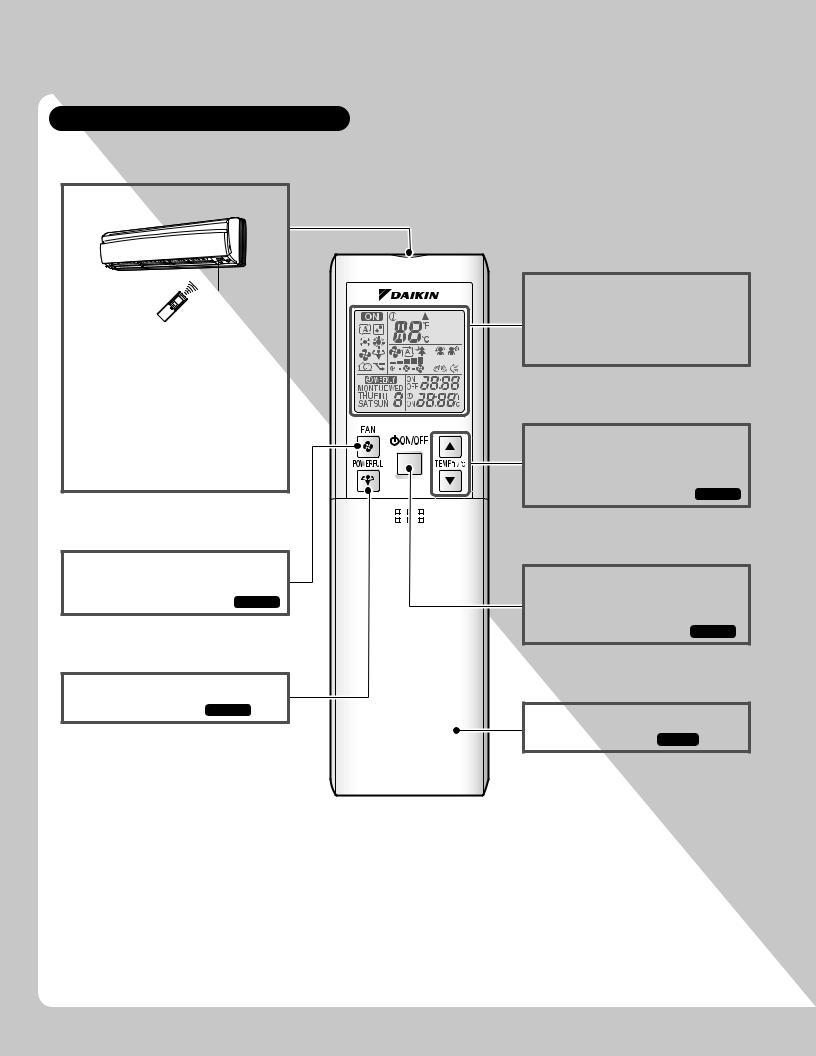
Names of Parts
Remote Controller: ARC452A21
Signal transmitter
Receiver
• To use the remote controller, aim the transmitter at the indoor unit. If there is anything to block signals between the unit and the remote controller, such as a curtain, the unit will not operate.
• Do not drop the remote controller. Do not get it wet.
• The maximum distance for communication is approximately 23ft (7m).
FAN setting button
• Selects the airflow rate setting.
 Page 11
Page 11
POWERFUL button
• POWERFUL operation  Page 17
Page 17
Display (LCD)
•It displays the current settings. (In this illustration, each section is shown with its displays on for the purpose of explanation.)
TEMPERATURE adjustment buttons
• Changes the temperature setting.
 Page 10
Page 10
ON/OFF button
•Press this button once to start operation.
Press once again to stop it.  Page 10
Page 10
Front cover
• Open the front cover.  Page 7
Page 7
6
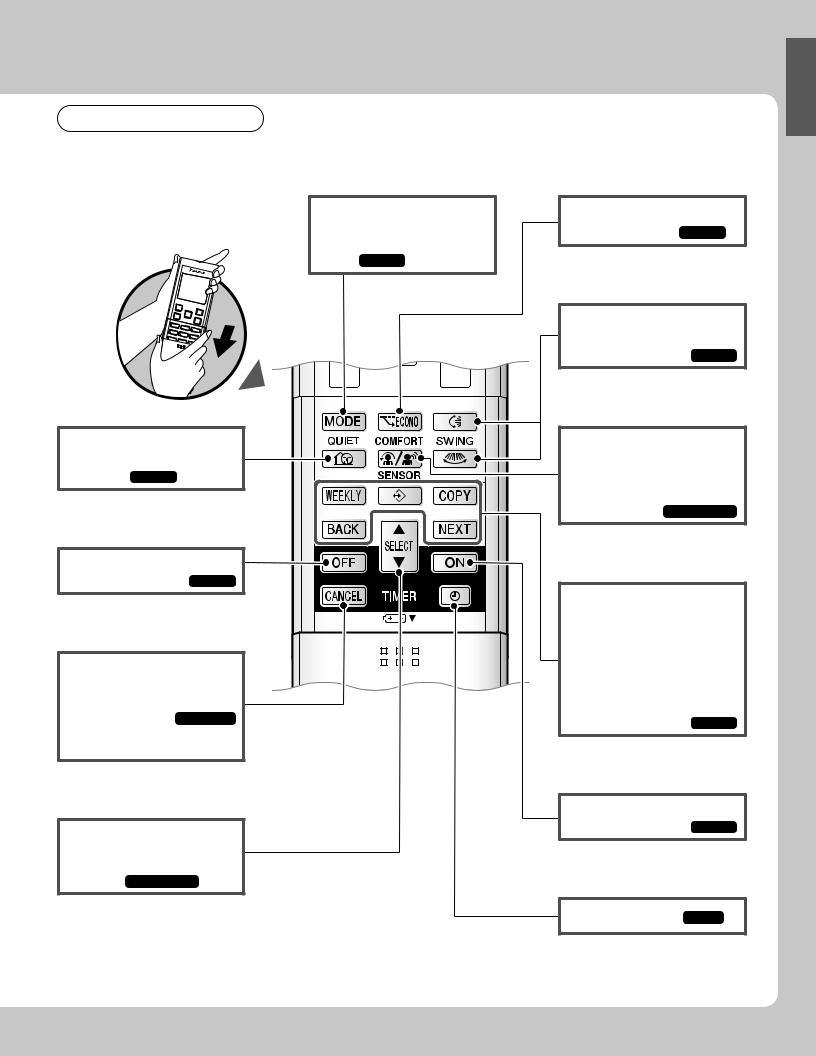
Open the front cover
MODE selector button
QUIET button
•OUTDOOR UNIT QUIET operation  Page 18
Page 18
OFF TIMER button
 Page 20
Page 20
TIMER CANCEL button
• Cancels the timer setting.
 Page 20,21
Page 20,21
•It cannot be used for the WEEKLY TIMER operation.
SELECT button
•Changes the ON/OFF TIMER and WEEKLY TIMER settings.  Page 20,21,23
Page 20,21,23
•Selects the operation mode. (AUTO/DRY/COOL/HEAT/ FAN)  Page 10
Page 10
English
ECONO button
• ECONO operation  Page 19
Page 19
SWING button
• Adjusting the airflow direction
 Page 12
Page 12
COMFORT/SENSOR button
•COMFORT AIRFLOW and INTELLIGENT EYE operation
 Page 14,15,16
Page 14,15,16
 : WEEKLY button
: WEEKLY button
 : PROGRAM button
: PROGRAM button
 : COPY button
: COPY button
 : BACK button
: BACK button
 : NEXT button
: NEXT button
• WEEKLY TIMER operation
 Page 22
Page 22
ON TIMER button
 Page 21
Page 21
CLOCK button  Page 9
Page 9
7
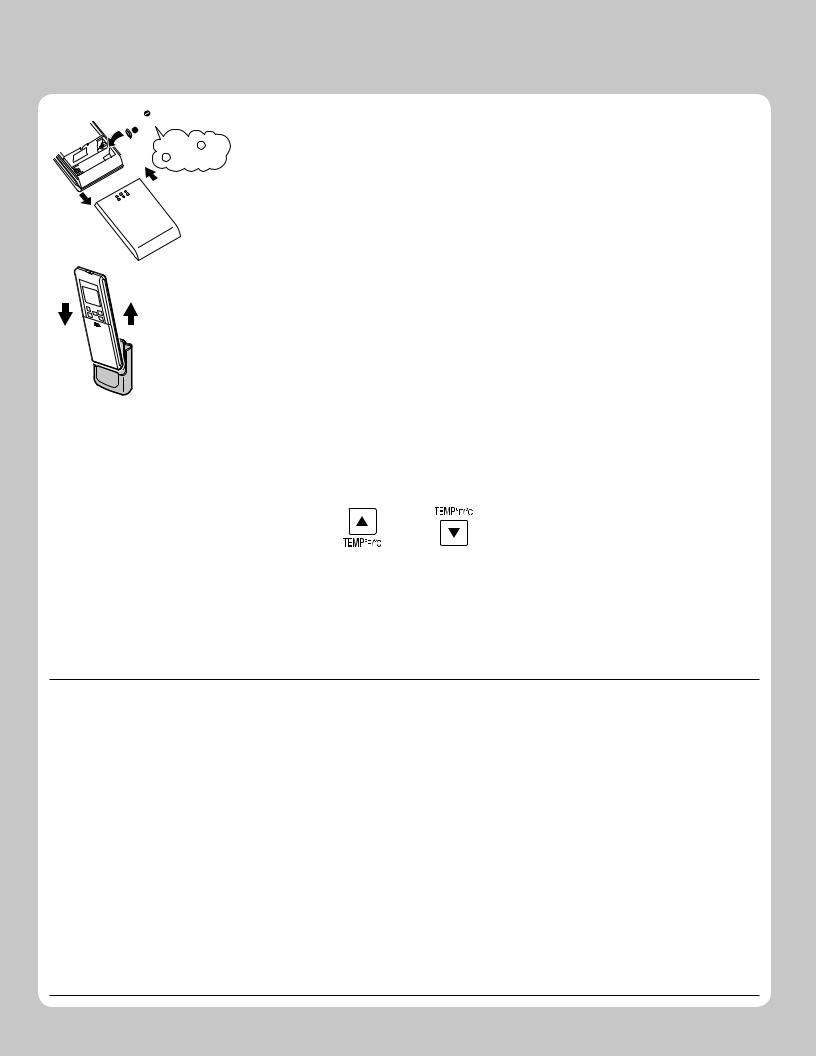
Preparation before Operation
2 

Position + and
– correctly!
3
1
Set. Pull.
 Remote controller holder
Remote controller holder
To set the batteries
1. Slide the front cover to take it off.
2. Set two dry batteries AAA.LR03 (alkaline).
3. Set the front cover as before.
To fix the remote controller holder on the wall
1. Choose a place from where the signals reach the unit.
2. Fix the holder to a wall, a pillar, etc. with the screws supplied with the holder.
3. Place the remote controller in the remote controller holder.
Celsius/Fahrenheit display switch
• The Celsius or Fahrenheit display is selectable with the following buttons.
Press |
and |
buttons simultaneously |
for 5 seconds.
• The temperature will be displayed in Fahrenheit if it is presently displayed in Celsius, and vice versa.
Turn the breaker on
•After the power is turned on, the louver of the indoor unit opens and closes once to set the reference position.
NOTE
Notes on batteries
•When replacing the batteries, use batteries of the same type, and replace both batteries at the same time.
•When the system is not used for a long time, take the batteries out.
•The batteries will last for approximately 1 year. If the remote controller display begins to fade and the degradation of reception performance occurs within a year, however, replace both batteries with new, size AAA.LR03 (alkaline).
•The attached batteries are provided for the initial use of the system.
The usable period of the batteries may be short depending on the manufactured date of the air conditioner.
Notes on remote controller
•Never expose the remote controller to direct sunlight.
•Dust on the signal transmitter or receiver will reduce the sensitivity. Wipe off dust with soft cloth.
•Signal communication may be disabled if an electronic-starter-type fluorescent lamp (such as inverter-type lamps) is in the room. Consult the shop if that is the case.
•If the remote controller signals happen to operate another appliance, move that appliance to somewhere else, or consult the service shop.
Celsius/Fahrenheit display change function of remote controller
•The set temperature may increase when the display is changed to Celsius from Fahrenheit, because a fraction of 0.5°C is rounded up.
•Example: A set temperature of 65°F (equivalent to 18.5°C) will be converted into 19°C.
When the display is changed to Fahrenheit again, the set temperature will be converted into 66°F (equivalent to 19°C) instead of the original set temperature (65°F) but a set temperature of 66°F (equivalent to 19°C) will be converted into 19°C with no temperature change.
• A reception sound will go off for the transmission of set temperature to the indoor unit at the time of setting the Celsius/Fahrenheit display change function.
8
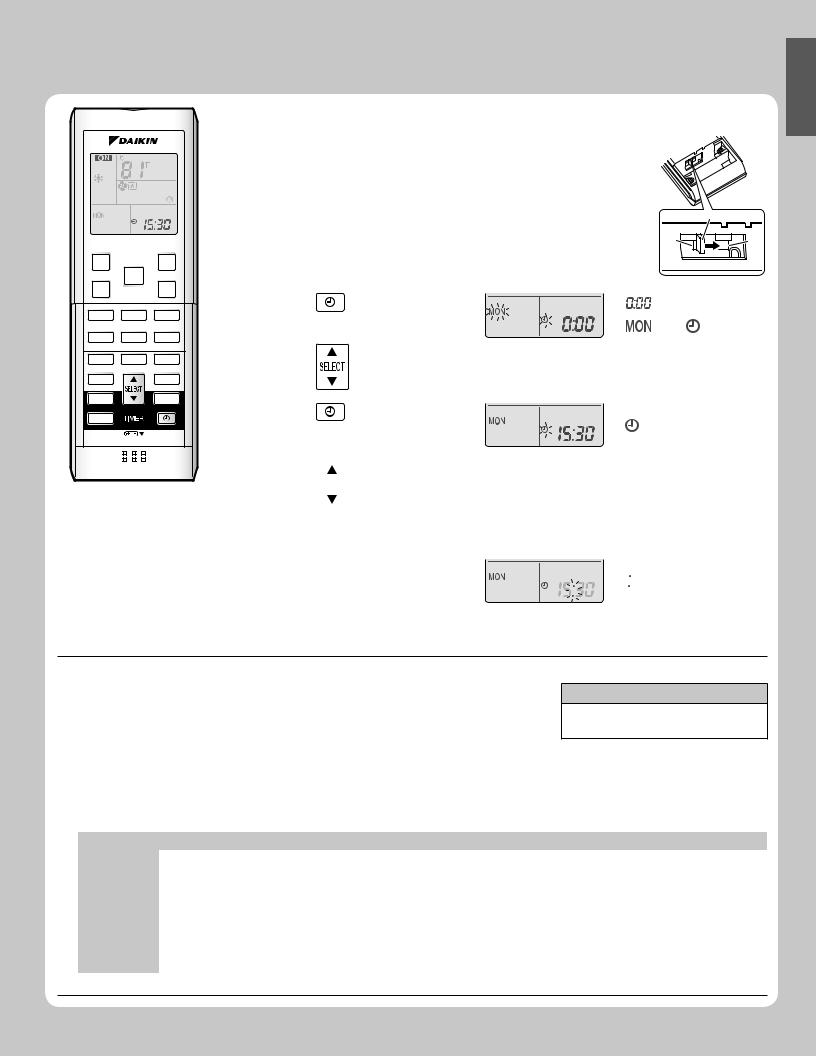
Checks on remote controller settings
• This remote controller is common to the heat pump model and cooling only model. Use the DIP switch on the remote controller to set the heat pump model or cooling only model.
• Refer to the following explanation and make the setting as shown in the
illustration.
DIP switch
• For customers of heat pump model: Set to H/P |
|
|
• For customers of cooling only model: Set to C/O |
H/P |
C/O |
To set the clock |
|
||
1. Press |
. |
“ |
” is displayed. |
|
|
||
|
|
“ |
” and “ ” blinks. |
2. Press |
|
to set the current day of the week. |
|
3. Press |
. |
“ |
” blinks. |
 4. Press
4. Press  to set the clock to the present time.
to set the clock to the present time.
• Holding down  or
or  rapidly increases or decreases the time display.
rapidly increases or decreases the time display.
5.Press  .
.
• Point the remote controller at the |
“ ” blinks. |
indoor unit when pressing the buttons. |
|
Operating conditions
• If the indoor unit’s internal clock is not set to the correct time, the WEEKLY TIMER will not operate punctually.
Tips for saving energy
• Be careful not to cool (heat) the room too much.
Keeping the temperature setting at a moderate level helps save energy.
• Cover windows with a blind or a curtain.
Blocking sunlight and air from outdoors increases the cooling (heating) effect.
•Clogged air filters cause inefficient operation and waste energy. Clean them once in about every 2 weeks.
Please note
•The air conditioner always consumes a small amount of electricity even while it is not operating.
•If you are not going to use the air conditioner for a long period, for example in spring or autumn, turn the breaker off.
•Use the air conditioner in the following conditions.
Mode |
Operating conditions |
If operation is continued out of this range |
|
Outdoor temperature : 50-115°F (10-46°C) |
• A safety device may work to stop the operation. |
COOL |
Indoor temperature : 64-90°F (18-32°C) |
• Condensation may occur on the indoor unit and drip. |
|
Indoor humidity : 80% max. |
|
HEAT |
Outdoor temperature : 5-75°F (–15-24°C) |
• A safety device may work to stop the operation. |
Indoor temperature : 50-86°F (10-30°C) |
|
|
|
|
|
|
Outdoor temperature : 50-115°F (10-46°C) |
• A safety device may work to stop the operation. |
DRY |
Indoor temperature : 64-90°F (18-32°C) |
• Condensation may occur on the indoor unit and drip. |
|
Indoor humidity : 80% max. |
|
• Operation outside this humidity or temperature range may cause a safety device to disable the system.
English
9
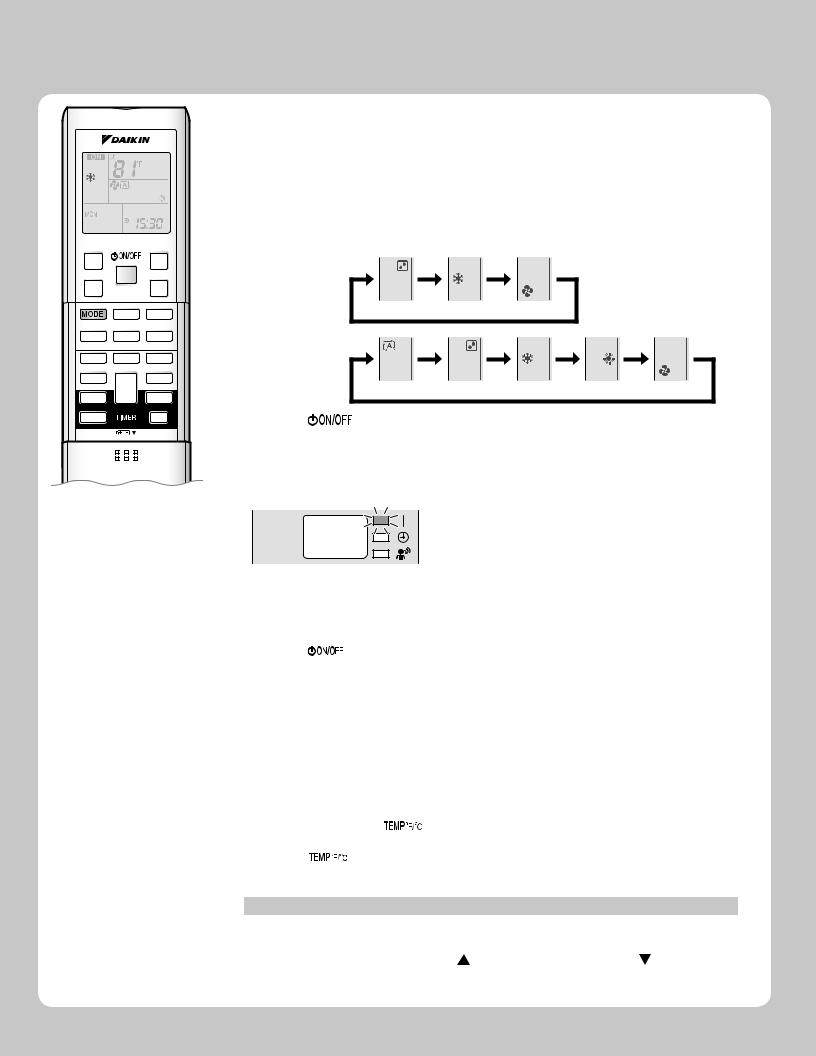
AUTO · DRY · COOL · HEAT · FAN Operation
The air conditioner operates with the operation mode of your choice.
From the next time on, the air conditioner will operate with the same operation mode.
To start operation
1. Press  and select a operation mode.
and select a operation mode.
• Each pressing of the button advances the mode setting in sequence.
COOLING ONLY |
|
|
|
model |
DRY |
COOL |
FAN |
HEAT PUMP |
|
|
|
|
|
model |
AUTO |
DRY |
COOL |
HEAT |
FAN |
2. Press  .
.
•“  ” is displayed on the LCD.
” is displayed on the LCD.
•The OPERATION lamp lights green.
Display
To stop operation
Press  again.
again.
•“  ” is no longer displayed on the LCD.
” is no longer displayed on the LCD.
•The OPERATION lamp goes off.
To change the temperature setting
Press  or
or  .
.
• The displayed items on the LCD will change whenever either one of the buttons is pressed.
DRY or FAN mode |
COOL mode |
HEAT mode |
|
AUTO mode |
|
64-90°F |
50-86°F |
|
64-86°F |
The temperature setting is not |
(18-32°C) |
(10-30°C) |
|
(18-30°C) |
|
|
|
|
|
variable. |
Press to raise the temperature and press |
to lower the |
||
|
temperature. |
|
|
|
|
|
|
|
|
10
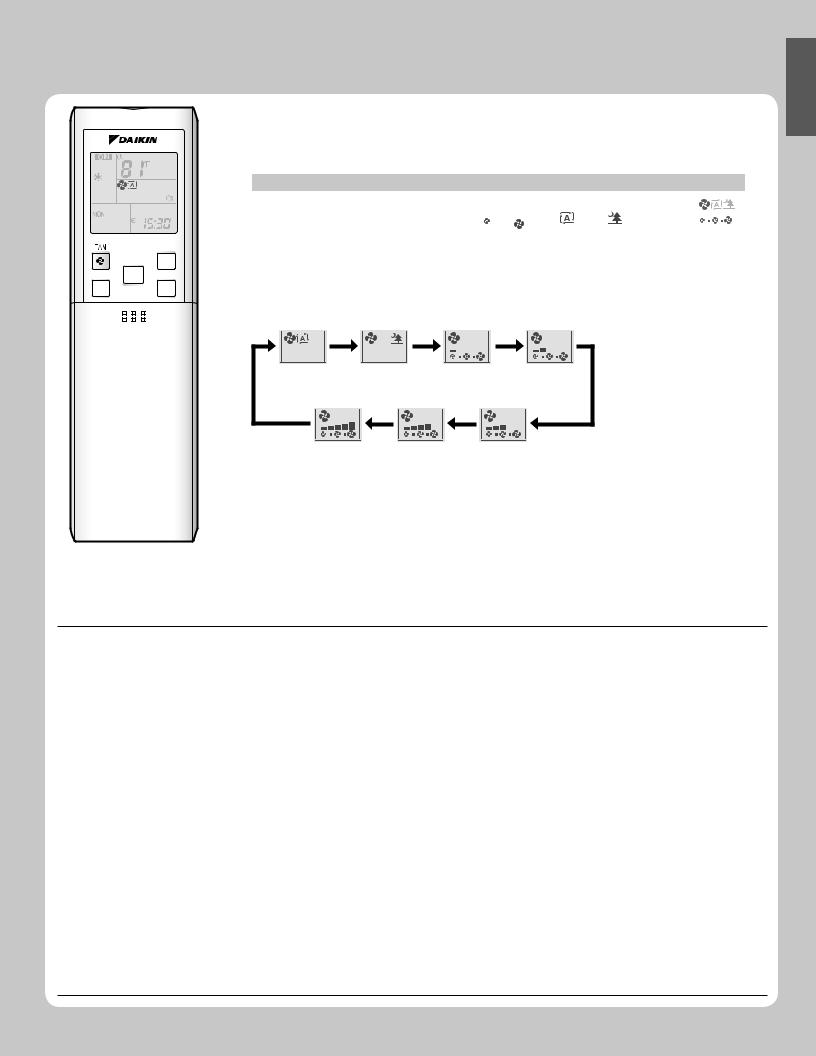
To change the airflow rate setting
Press  .
.
DRY mode |
|
|
AUTO or COOL or HEAT or FAN mode |
|||||||||
|
|
|
|
|
|
|
|
|
||||
The airflow rate setting is not variable. |
Five levels of airflow rate setting from |
|
|
|
|
|
|
|
||||
“ |
|
” to “ |
|
” plus “ ” and “ ” are available. |
|
|
|
|
|
|
|
|
|
|
|
|
|
|
|
|
|
|
|||
|
|
|
|
|
|
|
|
|
|
|
|
|
•Indoor unit quiet operation
When the airflow is set to “  ”, the noise from the indoor unit will become quieter. Use this when making the noise quieter.
”, the noise from the indoor unit will become quieter. Use this when making the noise quieter.
The unit might lose capacity when the airflow rate is set to a weak level.
•Each pressing of the button advances the airflow rate setting in sequence.
Auto |
Indoor unit quiet |
Low |
Middle low |
|
High |
Middle high |
|
Middle |
English
NOTE
Note on HEAT operation
•Since this air conditioner heats the room by taking heat from outdoor air to indoors, the heating capacity becomes smaller in lower outdoor temperatures. If the heating effect is insufficient, it is recommended to use another heating appliance in combination with the air conditioner.
•The heat pump system heats the room by circulating hot air around all parts of the room. After the start of heating operation, it takes some time before the room gets warmer.
•In heating operation, frost may occur on the outdoor unit and lower the heating capacity. In that case, the system switches into defrosting operation to take away the frost.
•During defrosting operation, hot air does not flow out of indoor unit.
Note on COOL operation
•This air conditioner cools the room by releasing the heat in the room outside. Therefore, the cooling performance of the air conditioner may be degraded if the outdoor temperature is high.
Note on DRY operation
•The computer chip works to rid the room of humidity while maintaining the temperature as much as possible. It automatically controls temperature and airflow rate, so manual adjustment of these functions is unavailable.
Note on AUTO operation
•In AUTO operation, the system selects an appropriate operation mode (COOL or HEAT) based on the room and outside temperatures and starts the operation.
•The system automatically reselects setting at a regular interval to bring the room temperature to user-setting level.
Note on FAN operation
•This mode is valid for fan only.
Note on airflow rate setting
•At smaller airflow rates, the cooling (heating) effect is also smaller.
11
